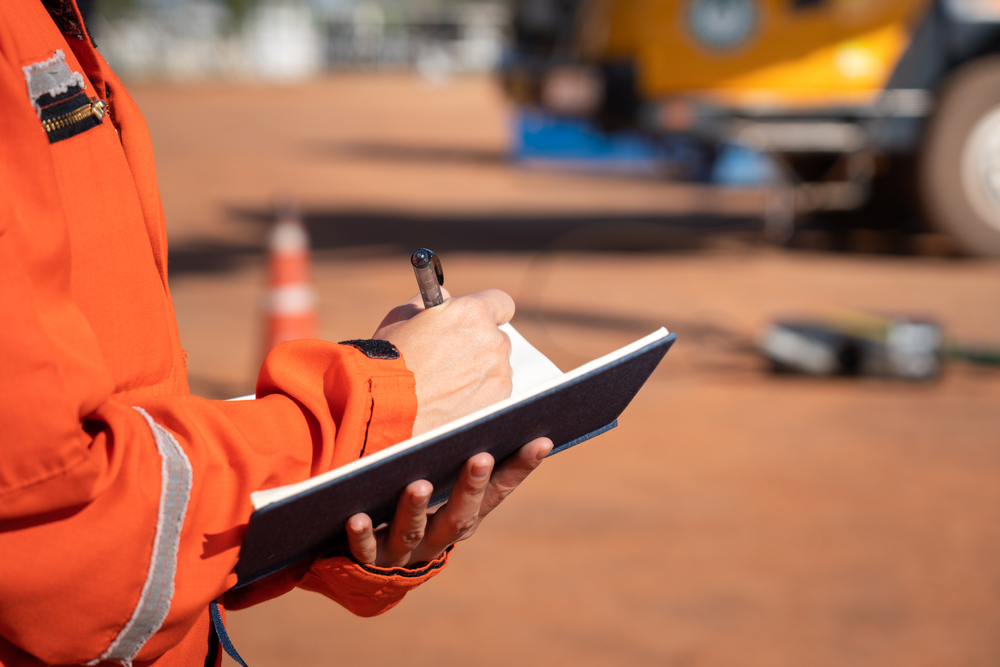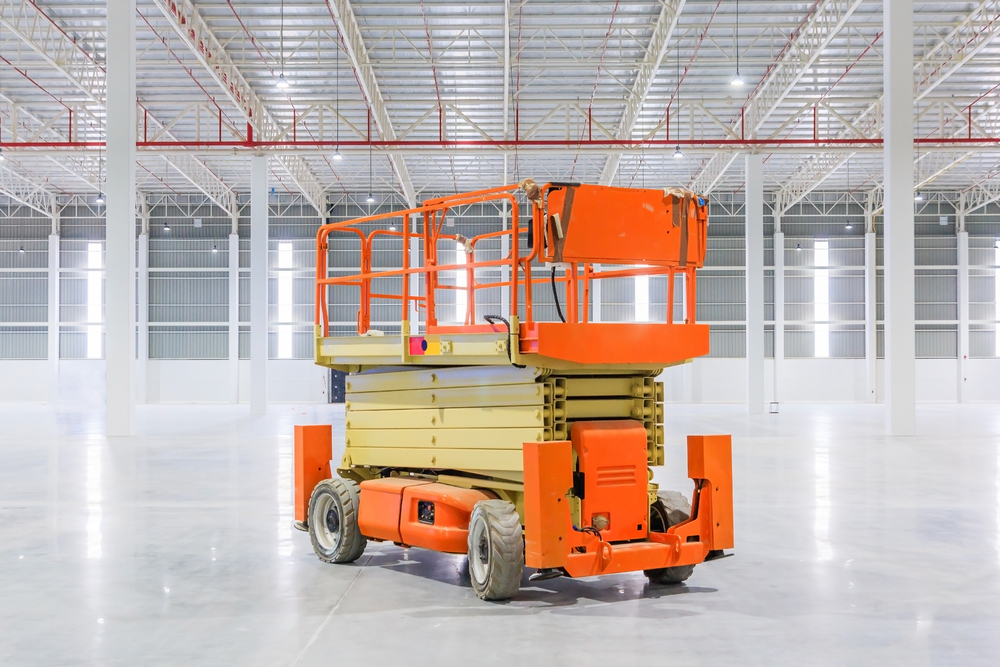Scissor Lift Safety Rules
Scissor lifts are incredibly powerful pieces of equipment. It’s no wonder they’re so popular in industrial settings and on construction sites. Featuring wide platforms that are large enough to accommodate workers and their equipment, scissor lifts provide a safe, stable environment to complete tasks. While there are certain risks with using scissor lifts, experienced workers know safety tips to help avoid accidents and injuries.
The proper training can go a long way when it comes to scissor lift safety. If your organization wants to avoid expensive OSHA penalties and reduce the odds of a workplace accident, it’s important to provide employees with thorough scissor lift training. While scissor lift safety tips can certainly help keep workers safe, it’s just as important to learn fundamentals like what is a scissor lift.
What is a Scissor Lift?
Just what is a scissor lift, you might ask? It’s a motorized vehicle that features a platform that can be raised vertically. It has crisscrossing metal supports and a platform mounted on folding arms that give the lift a distinct appearance.
Scissor lifts can be gas- or electric-powered and vary in terms of size. In addition, scissor lifts are often used in warehouses and other work areas where limited space is available.
Plus, scissor lifts offer a mobility advantage over traditional scaffolding. OSHA technically considers scissor lifts as a type of scaffolding, rather than an aerial work platform (AWP) or typical aerial lift.
See Also: 2025 OSHA Scissor Lift Harness Requirements
Scissor Lift Safety Tips
There are a number of strategies and tips workers can use to stay safe when using scissor lifts. OSHA scissor lift training should come first – it’s required by law. Employers must provide workers with adequate training and certification before they begin using these tools.
Before operating a scissor lift, employers are responsible for assessing the work area to identify any hazards that can cause accidents. It is essential to ensure there are no loose, damaged, or faulty parts of the equipment, and that the surrounding environment is free of hazards. A quick, five-minute risk assessment at ground level could be all it takes to prevent an injury or worse.
Beyond the inspection of equipment, here are a few more strategies to employ to avoid scissor lift accidents:
Fall Protection
Scissor lift safety starts with fall protection. Falls are one of the top causes of accidents involving large equipment, and certain aerial lift and scissor lift safety tips need to be considered to prevent workers from falling and getting injured or killed.
– Scissor lifts must have functioning guardrails to prevent operators from falling out of the platform
– Scissor lift workers are not required to have body harnesses and lanyards when guardrails are present, but individual company safety protocols can require scissor lift operators to wear safety harnesses.
– Workers must stand only on the platform, and not on the guardrails
– Workers should keep the work area close to the list to avoid having to lean away from the scissor lift
– Workers should never operate a lift alone.
Stabilization
Knowing what is a scissor lift isn’t enough to keep safe on the job. Workers must ensure scissor lifts are stable. This can help them avoid tipovers and collapses. Stability is one of the most important parts of construction site safety with scissor lifts. As one of the most effective ways to prevent the majority of scissor lift accidents, stabilization of the lift can be achieved using the following scissor lift safety tips:
– Follow all manufacturer’s instructions for moving on a scissor lift safely
– Make sure the scissor lift is not close to traffic or other equipment that can come into contact with the lift
– Position the scissor lift on solid, stable ground away from drop-offs, holes, bumps, slopes, and debris
– Only use scissor lifts in good weather conditions and not high winds
– Never exceed weight or height limits
Positioning
OSHA scissor lift training can help workers understand the importance of proper positioning and how to avoid crushing and electrocution accidents. Workers both on and near a scissor lift are at risk for crushing hazards, which can happen when a moving scissor lift is near a fixed object, a scissor lift is close to moving vehicles, a scissor lift passes underneath a fixed object. Electrocutions can happen to workers on the platform who are near power lines, even if neither the lift nor the worker comes into contact with the live line. Hazards related to scissor lift positioning are directly related to a handful of the most common OSHA safety violations year after year. Scissor-lift workers can prevent electrocutions and crushed-by accidents with the following scissor-lift safety tips:
– Position the scissor lift at least ten feet away from power lines to avoid electrocution
– Use traffic control measures to separate the scissor lift from other workers or vehicles. Smart planning with traffic cone placement helps route foot traffic away from potentially dangerous areas around a working scissor lift.
– Use ground guides around the scissor lift in the work zone
– Ensure your overhead is clear of electrical wires and other fixed objects
Maintaining Scissor Lifts
Beyond understanding what is a scissor lift, workers must also learn to maintain these machines. Scissor lifts are only kept safe for use through regular maintenance. Workers should review the manufacturer’s instructions to learn how to:


– Perform pre-inspection checks and environment inspections
– Perform maintenance on the equipment
– Ensure safety systems are not bypassed
– Ensure guardrails are in good condition
– Verify the emergency stop button is functional
– Test the brakes to ensure the scissor lift can be safely stopped at any time
Training for Operators
All employers of scissor lift operators are required to provide OSHA scissor lift training to teach workers how to operate scissor lifts safely and understand all scissor lift safety rules. Training should consist of the following scissor lift safety tips and instructions at the minimum:
– How to understand the manufacturer’s instructions for operating a scissor lift while in the raised position and while traveling
– How to handle materials on the scissor lift, and be aware of the weight limitations
– What worksite hazards to look for and how to avoid them
– How to report any defects that require repairs
Scissor lift training also teaches workers how to perform a thorough assessment of the surrounding environment to check for any red flags. Scissor lift safety tips come into play not only when inspecting the equipment, but also the work area because you truly can never be too careful. Even if the work zone has already been deemed as safe, it is each worker’s responsibility to perform their inspections to confirm their safety.
What Are the Most Common Scissor Lift Safety Hazards?
The safety of scissor lifts varies based on the employer and lift operator. If an employer provides workers with proper OSHA scissor lift training, it can boost safety across its worksites. On the other hand, if scissor lift operators are untrained or ignore safety protocols, they can put themselves and others at risk.
According to the Bureau of Labor, scissor lifts are responsible for eight workplace fatalities each year. The Health and Safety Executive (HSE) has issued a safety alert focusing specifically on the need to regularly maintain, inspect, and test safety equipment. The HSE warning applies to operators of scissor lifts, scissor lift engineers, and rental and training companies.
Common scissor lift safety risks include:
Poor Maintenance
If a scissor lift is not properly maintained, performance issues can arise that put lift operators and bystanders in danger.
Improper Positioning
Using a scissor lift too close to power lines puts an operator at risk of electrocution. Also, positioning a scissor lift too close to a support beam, door frame, or another fixed object could crush an operator.
Insufficient Training
A scissor lift operator who does not know how to safely use a lift puts himself or herself and others at risk of scissor lift accidents and injuries.
Safety is a top priority for any business that employs scissor lift operators. If these operators know how to identify and alleviate risks, they are well-equipped to guard against accidents and injuries.
The Major Causes of Scissor Lift Accidents
When workers ignore scissor lift safety requirements, injuries, and accidents are more likely to occur. That’s why training and a basic comprehension of scissor lift safety rules is important. According to OSHA’s Hazard Alert scissor lift bulletin, there are different factors that cause scissor lift accidents, including:
– Stability concerns
– Overhead hazards
– Bad weather
– Improperly working safety devices
– No fall protection harness
OSHA’s scissor lift safety rules help prevent the most obvious accident causes.
How Can Scissor Lift Certification Training Improve in Preventing Injuries?
You might be asking yourself: does OSHA require certification for scissor lift operators? The answer is a resounding yes. All workers must be properly trained and certified before they begin using scissor lifts. Untrained and inexperienced employees are far more likely to be involved in an accident. By properly educating employees, your organization helps foster a culture of safety and efficiency.
CertifyMeOnline.net offers convenient, affordable OSHA scissor lift training for new and experienced operators alike. Scissor lift training can be completed in about an hour’s time, ensuring OSHA compliance and a safer work environment for everyone. If you’re ready to enroll your employees in CMO’s OSHA scissor lift safety training, call us at 602-277-0615 to speak with one of our OSHA experts, or you can also visit our online contact page for more information.
Also see: Scissor Lift Controls

